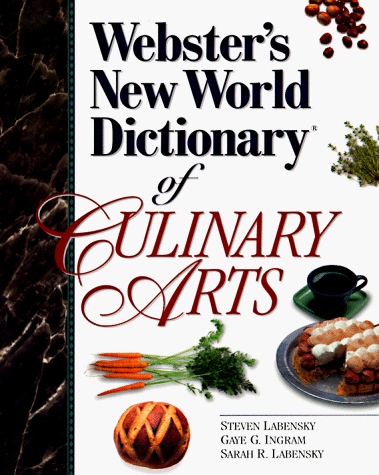Webster's New World "TM", the most widely recognized and respected name in dictionaries, continues its tradition of excellence with the first ever Dictionary of Culinary Arts.
This unique exceptionally comprehensive dictionary contains over 16,000 entries covering food identification, preparation and cooking methods, nutrition, sanitation, tools and equipment, wine, beer and spirits, international foods, food chemistry, historical and cultural terms, and prepared dishes.
-- Authoritative yet concise entries
-- Accurate use of capitalization and accent marks
-- Simple, alphabetical listing for all entries, including abbreviations
-- Extensive cross-references
-- 160 line drawings
-- Easy to read typeface and format
-- Phonetic pronunciation guides
plus tables of metric conversions, measurement equivalents, sugar cooking temperatures and more!
Webster's New World "TM", Third College Edition is the dictionary of choice for wire services, The New York Times, the Los Angeles Times and hundreds of newspapers and periodicals worldwide.
Prentice Hall is taking advantage of the Webster's name in this title of a new dictionary of cooking. The three authors have written definitions for more than 16,000 culinary terms. Labensky appears to be the only author with a culinary background, having written a recent cooking-technique textbook with an accompanying videocassette.
The definitions are short, usually less than two sentences. Pronunciation is included for less familiar or foreign terms--levain, oyako nabe, sofrito. There are foreign words from Dutch, Portuguese Romanian, Swahili, Turkish, and many from Polish. Proper names are also defined--Beard, James, Jelly Belly, Shirley Temple, Spam, Spa Food. See references are used, although terms that appear within entries but also have entries of their own are not indicated. For example, country gravy is mentioned in the chicken-fried steak entry, but there is nothing to show that it also appears as a separate entry. The only illustrations are a few line drawings interspersed throughout the text. Most of the illustrations are for equipment--a sandwich spreader, an ice chipper, a reamer. Appendixes list metric equivalents, temperature equivalents, and stages of cooked sugar.
This is a good choice for cooking collections that need definitions only. The Cook's Dictionary and Culinary Reference (Contemporary Books, 1996) and Food Lover's Companion (2d ed., Barron's, 1995) contain derivations as well as definitions but have far fewer entries.
